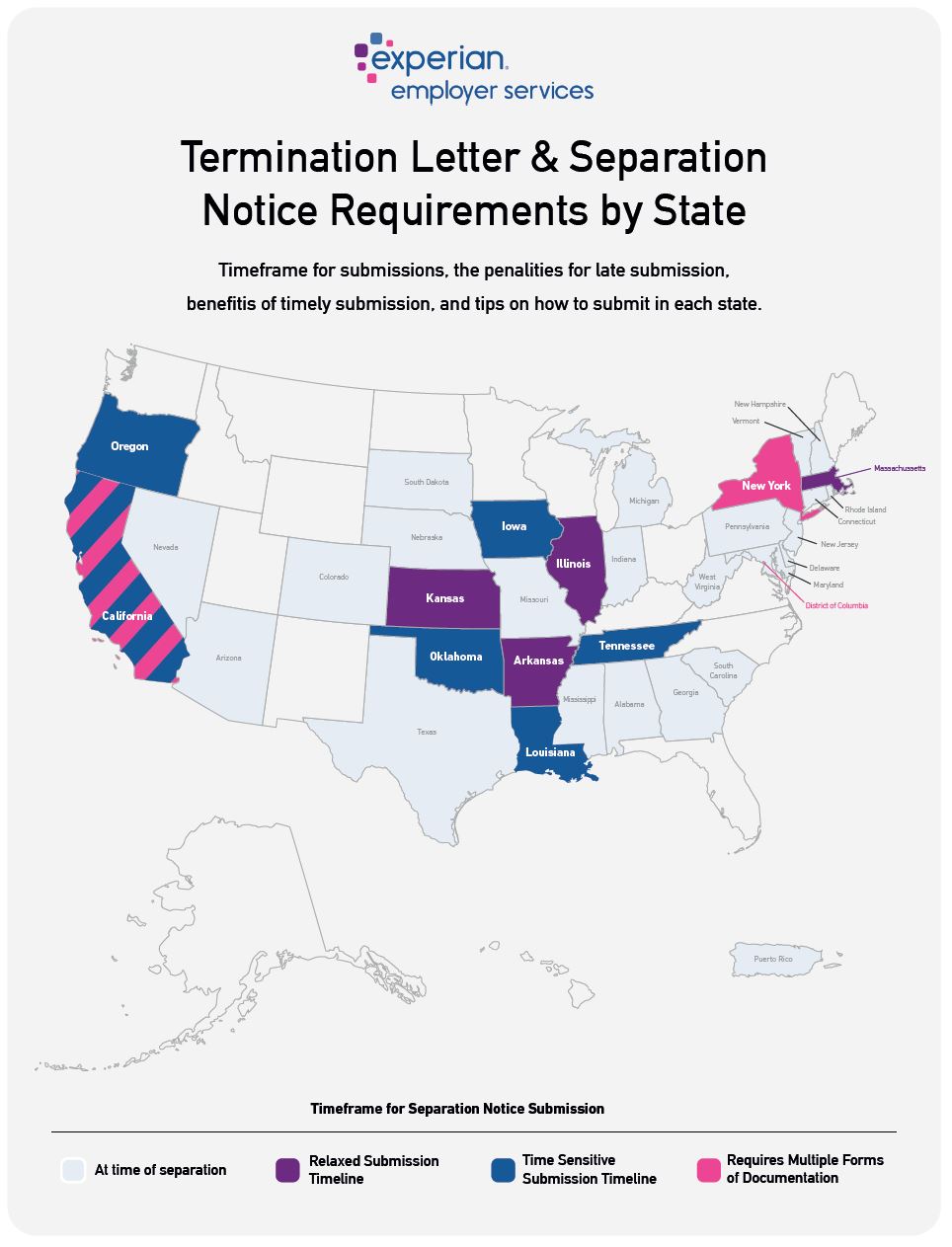
When an employer terminates an employee’s position, it is essential to understand the regulations that govern the separation process, especially considering the state in which they operate. There are several points to consider when it comes to separation notice requirements and unemployment insurance law.
Different states have varying rules regarding separation notices or termination letters. Employers should keep track of these requirements to avoid non-compliance issues. Some states mandate a specific form that employers must provide to an employee upon termination. These notices typically inform employees of their rights to file for unemployment benefits. Employers should be aware of the statutory separation notice requirements in each state where they operate.
A termination letter or separation notice usually includes information about the employee’s rights, including the ability to file for unemployment benefits. In some cases, basic separation details are shared by the employer with the state agency so if an employee files an unemployment claim, initial separation information is available to the state workforce personnel who is adjudicating the claim.
Employers should also know when and how to deliver separation notices. Employers will find many options for providing these notices to state workforce agencies and choose the method that is most expeditious since timeliness is crucial to ensure compliance and avoid penalties of any kind.

Managing unemployment compliance across multiple states can be complex and time-consuming. To help streamline this process, consider using Experian Employer Services. We offer expertise in unemployment cost management, claims administration, hearings representation and more. By partnering with experts like Experian Employer Services, employers can reduce the risk, cost and burden associated with unemployment claims administration while ensuring compliance to state-specific regulations.
Remember, staying informed about state-specific requirements and leveraging specialized services can help employers navigate the complexities of multi-state unemployment compliance. If you would like to learn more, visit Experian Employer Services.
Separation Notice Requirements by State

While most states do not penalize employers for failing to send a specified separation notice, several states have associated penalties if you do not provide the required form informing individuals of unemployment benefits. The following information is not updated in realtime.
Louisiana Workforce Commission
One state to note that has a statutory requirement is the Louisiana Workforce Commission. Louisiana requires employers to submit a Separation Notice (LWC-77) within 72 hours of a worker’s separation. LWC-77 is not an unemployment claim. Failure to comply with this policy will result in the prohibition of non-charging to the employer’s UI account. LWC-77 must be completed online and a copy provided to the separating employee in-person or by mail within three days of separation.
LWC-77 is most applicable when there are base-period claims and chargeability cases. In Louisiana, chargeability cases are based on establishing a disqualifying separation, timely response to the unemployment claim and Form 77 being submitted to the state and claimant within 72 hours. The employer will be charged if proof to all three factors can’t be provided. Since this is not a response to a UI claim and no determination as to UI benefits will be made from this form, the individual that completes the form should list themselves as the contact. Louisiana employers should follow these steps once a worker becomes separated:
- Submit LWC-77 online
- Provide a copy of the Separation Notice and Required Notification to Separating Employees of Availability of Unemployment Compensation to the separated worker either in-person or mailed to their last known address within three days
- Copy the envelope you are using to send the form in case any disputes arise during the workforce process
- Do not request a signature as the claimant could deny the package and they wouldn’t receive the form
Massachusetts
An employee must be provided with Form 0590-A “How to File a Claim for Unemployment Insurance Benefits”, delivered in-person or sent to the employee’s last known address via USPS within 30 days of separation. Each failure to post the information described herein shall result in a written warning by said division to the employer for a first violation, and thereafter shall result in the assessment of a civil fine of $100 for a second violation, $250 for a third violation, and $500 for a fourth and subsequent violations. Said division shall collect all fines assessed for violations of this subsection for deposit into the General Fund.
Maryland
Employers must provide a notice of unemployment availability to separated employees through a letter, email, or text. The notice includes the recommended templates. An employer that fails to submit a separation notice or report of wages under subsection (a) of this section is subject to a penalty of $15 for each notice unless the Secretary waives the penalty for cause.
Michigan
Form IA 1711 “Unemployment Compensation Notice to Employee” must be provided to an employee upon separation unless an employer is filing claims on behalf of the employee. (2) If the agency finds that an employer fails to deliver form UA 1711 or the equivalent written notice before separation or fails to post adequate notices concerning replacement of a lost form UA 1711 or an equivalent written notice, then the employer, at the direction of the agency, shall be required to deliver form UA 1711 or the equivalent written notice to a worker when the worker is separated from employment. Form UA 1711 or the equivalent written notice shall be considered a report within the meaning of section 54(c)(1) of the act, and the agency may impose the penalty of $10.00 against an employer that fails to provide the form or the equivalent written notice to the worker by the date of the worker’s separation from employment and will only be imposed if an employer fails to comply with this requirement after being notified by the agency. Imposition of the penalty provided under this rule is an appealable issue under the act.
New Jersey
Form BC-10: Instructions for Claiming Unemployment Benefits must be given to employees that separate for whatever reason at the time of separation. Please note, legislation was passed in 2023 requiring employers to immediately and simultaneous to providing it to the separated employee, , electronically send this form to the state agency, however, no formal procedures have been published by the NJ DOL. So that statute is not currently being enforced. When the requirement is enforced, a penalty will be assessed of $500 or 25% of any amount of unemployment benefits fraudulently withheld, whichever is greater.
Below is a list of additional separation notice requirements by state and U.S. territories with no associated penalties at the time of publication:
| State/Territory | Document | When to Provide |
| Arkansas | Unspecified notice of availability of unemployment compensation. | As soon as practicable but not to exceed seven days from the last day of work (LDW) for the employee. |
| Alabama | Notice of availability of unemployment compensation. | Time of separation. |
| Arizona | UIB-1241A: Arizona Take Care of Unemployment Business by the Internet or Telephone | Not specified. |
| California | DE 2320: For Your Benefit: California’s Programs for the Unemployed Employers are also required to provide written notice to an employee upon a change in employment status (including a leave of absence). The EDD’s website provides this sample notice that meets the minimum requirements. | Time of separation. |
| Colorado | Form 22-234: Availability of Unemployment Notice | Time of separation. |
| Connecticut | Form UC-61: Information for Filing Your Initial Unemployment Claim | Time of separation. |
| Delaware | Form UC-300: Notice of availability of unemployment compensation. | Time of separation or mailed within 24 hours. |
| Georgia | DOL – 800: Separation Notice | LDW or mailed within three days of the date of separation. |
| Iowa | Form 60-0154: Notice of Separation or Refusal to Return to Work. This notice can also be completed online at https://uiclaims.iwd.iowa.gov/EmployerSeparation | Time of separation. |
| Illinois | CLI 111L: What Every Worker Should Know about Unemployment Insurance | Time of Separation or mailed within five days of separation. |
| Indiana | Unspecified notice of availability of unemployment compensation. | Time of separation. |
| Kansas | K-CNS 405: Notice to Worker about Unemployment Insurance (Unemployment Insurance Poster) | Must be posted in a conspicuous place for current employees. |
| Mississippi | Report a separation or refusal to work at the state’s website. | Time of separation. |
| Missouri | MODES-INF-170-11: Information for Workers | Time of separation. |
| Nebraska | Unemployment Insurance: Advisement of Benefit Rights | Time of separation. |
| New Hampshire | NHES 0040: Unemployment Notice | Time of separation. |
| Nevada | NUCS-4139: NV Information for the Unemployed Worker | Time of separation. |
| New York | IA12.3: NY Record of Employment | Time of separation. |
| Oklahoma | Rights and Responsibilities of the Unemployed Worker | Upon request. |
| Oregon | Public employers must provide information to employees of unemployment benefits. | Upon request. |
| Pennsylvania | UC-1609: Employer Information | Time of separation. |
| Puerto Rico | Unspecified notice of availability of unemployment compensation. | Time of separation. |
| Rhode Island | All employers must provide notice to separating employees of the availability of unemployment compensation. | At the time of the employee’s separation from employment, provided individually to separating employees. |
| South Carolina | Notification of the Availability of Unemployment Insurance Benefits. | Time of separation. |
| South Dakota | Unspecified notice of availability of unemployment compensation. | Time of separation. |
| Tennessee | LB-0489: Separation Notice | Within 24 hours of separation. |
| Texas | Y-10C(0420): TX Workforce Commission Attention Employees | Time of separation. |
| Vermont | An employer shall provide an individual with notification of the availability of unemployment compensation. The notification may be based on model notification language provided by the U.S. Secretary of Labor. | Time of separation. |
| District of Columbia | You May be Eligible for Unemployment Benefits if You Lose Your Job | Must post and maintain printed notices to individuals employed by the employer. |
| West Virginia | WVUC-B-59: Workforce West Virginia Notice to Employees – Unemployment Benefits | Time of separation. |
Stay on Top of Separation Notice Requirements by State
Staying informed about separation notice requirements by state, their regulatory changes and various state-required termination letters can be time-consuming for an internal HR team or open an organization up to compliance errors with potential penalties. Experian Employer Services offers solutions for compliance form delivery increase efficiency and compliance to save money overall.
What is a Separation Notice?
A separation notice is a formal document given to an employee and/or the state that informs the employee is separating from the company. Often, separation notice requirements by state help ensure employees know their rights to file for unemployment benefits, the state has accurate account and address information to notify the employer, and a way to verify the accuracy of separation information provided by the claimant.
What is the Purpose of a Separation Notice?
Separation notices are given when an employee is let go either temporarily or permanently and state why the employee is separating. This helps ensure the employee has necessary information to file an unemployment claim and provides the state with the information they need to ensure prompt processing of the claim.
Termination Letter & Separation Notice State Requirements FAQs
What Should a Separation Notice Include?
State separation notices vary by state; some may require employers to provide certain information while others do not. However, most state separation notices include the following information:
- Business name
- Employer’s state unemployment account number and mailing address
- Employee name
- Date of letter
- Date of termination
- Reason for termination
- Company property, such as laptops or cellphones
- Last paycheck details
- Benefits, severance or compensation package information
How much detail about the separation should be included on a Separation Notice?
Separation notices typically only require a basic statement related to the reason for separation, and it is our recommendation that this be a standard practice by employers. If the claimant files a claim for unemployment benefits, the employer is asked to provide all details and at that time.
Providing a Separation Agreement in addition to a Separation Notice?
There may be times when a legal separation agreement is presented to the employee that may provide a separation payment with a stipulation included that the employee will not file litigation related to their separation in a number of arenas. It is important to note that an employee cannot agree to waive their right to file for unemployment benefits as part of a separation agreement. It varies across the nation on how the states treat separation agreements with a clause included that an employee will not file for unemployment benefits. In some states only the specific section that includes unemployment is deemed invalid, in others, the entire separation agreement is invalid if a waiver of unemployment benefits is included, and in a few, the employer is guilty of a criminal misdemeanor if waiving unemployment benefits is included in a separation agreement.
Does a Separation Notice Have to Be in Writing?
Yes, in most cases, a notice of separation has to be in writing. However, some states may allow for separation notices to be sent electronically.
Does a Separation Notice Mean You Were Fired?
No. Separation Notices are required regardless of the reason for separation, so they must be provided in both voluntary and involuntary separations regardless of the reason.
Does a Separation Notice Affect Future Employment?
Providing a written separation notice does not have an impact on an employee’s eligibility for rehire since it is required in some situations that could be temporary in nature such as a short-term layoff or leave of absence, or in a situation where an employee resigned due to personal reasons and would be a welcome addition if they reapplied in the future. Eligibility for rehire is not required data on most state separation notices, so this would be retained in your HR files for future reference if the employee reapplies.


